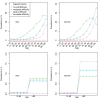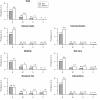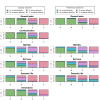Prevalence and features of ICF-disability in Spain as captured by the 2008 National Disability Survey
- PMID: 22122806
- PMCID: PMC3280204
- DOI: 10.1186/1471-2458-11-897
Prevalence and features of ICF-disability in Spain as captured by the 2008 National Disability Survey
Abstract
Background: Since 1986, the study of disability in Spain has been mainly addressed by National Disability Surveys (NDSs). While international attempts to frame NDS designs within the International Classification of Functioning, Disability and Health (ICF) have progressed, in general, the ICF has hardly been used in either the NDS or epidemiological studies. This study sought to identify ICF Activity- and Participation-related content in the most recent Spanish NDS, the 2008 Survey on Disabilities, Independence and Dependency Situations (Encuesta sobre discapacidades, autonomía personal y situaciones de Dependencia - EDAD 2008), and estimate the prevalence of such ICF-framed disability.
Methods: EDAD 2008 methods and questions were perused. Of the 51 EDAD items analysed, 29 were backcoded to specific d2-d7 domains of the ICF Checklist and, by rating the recorded difficulty to perform specific tasks with or without help, these were then taken as performance and capacity respectively. A global ICF score was also derived, albeit lacking data for d1, "Learning and applying knowledge", d8, "Major Life Areas" and d9, "Community, Social and Civic Life". Data were grouped by sex, age, residence and initial positive screening, and prevalence figures were calculated by disability level both for the general population, using the originally designed weights, and for the population that had screened positive to disability. Data for institutionalised persons were processed separately.
Results: Crude prevalence of ICF severe/complete and moderate disability among the community-dwelling population aged ≥6 years was 0.9%-2.2% respectively, and that of severe/complete disability among persons living in sheltered accommodation was 0.3%.Prevalence of severe/complete disability was: higher in women than in men, 0.8% vs. 0.4%; increased with age; and was particularly high in domains such as "Domestic Life", 3.4%, "Mobility", 1.8%, and "Self-care", 1.9%, in which prevalence decreased when measured by reference to performance. Moreover, global scores indicated that severe/complete disability in these same domains was frequent among the moderately disabled group.
Conclusions: The EDAD 2008 affords an insufficient data set to be ICF-framed when it comes to the Activity and Participation domains. Notwithstanding their unknown validity, ratings for available ICF domains may, however, be suitable for consideration under the ADL model of functional dependency, suggesting that there are approximately 500,000 persons suffering from severe/complete disability and 1,000,000 suffering from moderate disability, with half the latter being severely disabled in domains capable of benefiting from technical or personal aid. Application of EDAD data to the planning of services for regions and other subpopulations means that need for personal help must be assessed, unmet needs ascertained, and knowledge of social participation and support, particularly for the mentally ill, improved. International, WHO-supported co-operation in ICF planning and use of NDSs in Spain and other countries is needed.
Figures




References
-
- World Health Organization. World Health Organization International Classification of Functioning, Disability and Health. 2001.
-
- Cieza A, Ewert T, Ustun TB, Chatterji S, Kostanjsek N, Stucki G. Development of ICF core sets for patients with chronic conditions. J Rehabil Med. 2004;44(Suppl):9–11. - PubMed
Publication types
MeSH terms
LinkOut - more resources
Full Text Sources
Medical

